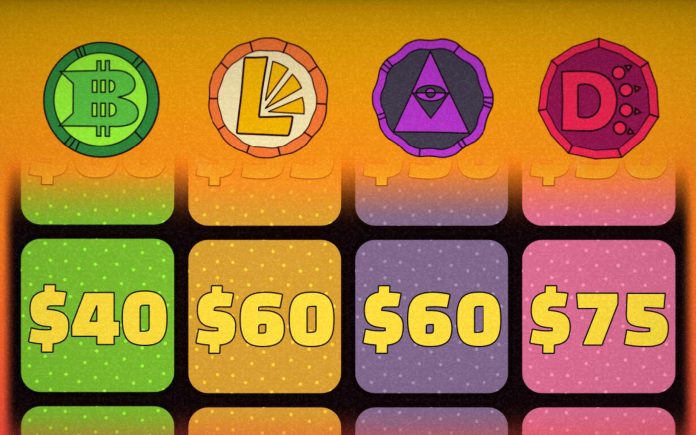I’ve just spent the last hour or so having a good time while working out how to play Flipto, the new roguelike slot machine sim by the eloquently named developer, Wayne Made a Game.
In fact, it was Wayne himself who reached out, shared a copy of his game, and who enticed me into the shadowy world of crypto-currency and cut-throat capitalism.
This might not be the kind of video game that an old hippy like me is typically drawn to, but you should never judge a book by its cover, as they say. And so I dived in, and in doing so I quickly realised that the crypto theme was mostly just a wrapper for a slot machine simulator in a similar vein to an old favourite of mine, Luck Be a Landlord.
And yes, there are a lot of similarities between Flipto and Luck Be a Landlord, and no, neither of them are particularly flattering about capitalism itself. However, after a few minutes of pulling on the one armed bandit (that sounds like a terrible euphemism, but I’m not editing it out), a very different experience started to emerge.

How does Flipto work?
The opening few minutes were somewhat overwhelming if I’m honest, as the introduction whisks you through a bunch of fairly nuanced mechanics before throwing you into the game proper. After that, though, I found my bearings pretty quickly.
I’ve mentioned the video game inspiration already, but Flipto also strongly reminds me of pattern-based board games such as Azul and Sagrada. I love this type of visually complicated puzzle experience, and Flipto brings a very similar energy to the screen. The aim of the game is to make combinations of symbols on a board, and this is done by nudging elements gently around and by trying to find the best synergies possible with the tools in front of you at any given moment.
Each round in Flipto is a bit like Balatro in the sense that you’ve got a number to hit before you can advance to the next. Within that round you have a number of actions that you can perform – spins, nudges, and strikes – but the fewer you use the more money you get at the end, so it pays to be frugal and play as efficiently as possible.

Every round ends when you make enough money or when you have run out of actions, at which point, as you’ve not met the financial quota, it’s GAME OVER. You get the sack from your job as a crypto trader, and you go back to being poor, I guess.
Symbolic Selling
Where Flipto is getting interesting is in how quickly the puzzles start to get complicated. It took around half an hour for me to piece things together, and truly understand the balance it makes you strike as you assess your options. Do you try to extract as much value from the board before you, or do you spin it again and take your chances?
You have a limited number of spins, and each time you do so it changes the whole board – a hard reset, if you will. However, once you’ve made your spin, you need to make sense of everything in front of you, and sniff out a sequence of moves that’ll make you a mint. To that end, you can nudge this column or that in order to make combinations out of the different symbols that are in play.
There are four crypto currency types in the game, and you’ve got to line them up into collections – all of the same type, or a full house of all four – to get paid. Alternatively, you can hit individual symbols to extract the value of that tile, but then you can’t use it again until you’ve made another spin.

On top of that, you’ve got trinkets that you add to your rig that give you permanent buffs, plus mods that perform timely temporary actions when called upon. You also need to trade in the four different currencies, buying low and selling high, and this is also done between rounds. Doing so adds funds to your account for buying more gear as well as unlocking new inventory slots as well as lines on the board.
In fact, unlocking new lines on the board broadens the number of ways that you can extract value from each spin, however, once you’ve got several of them unlocked, it can start to feel like a huge, brain-melting puzzle. This feeling is even more acute when you factor in the fluctuating values of the different coins and the different tools in your inventory.
Buy or sell?
I’ve not played long enough for this to be considered a review, and I don’t think I’ve seen enough to wholeheartedly recommend it just yet, either. However, Flipto is already proving to have surprising depth in some interesting areas, and I found it to be really quite engaging.
It didn’t take long before I was staring intently at the board, trying to work out how best to advance, my brain tick, tick, ticking away at the colourful challenge in front of me. It feels like one of those puzzle games where the harder you think, the more it makes your head hurt.
I’m not personally interested in the theme, if I’m honest, but the gameplay so far has proven to be a fascinating mix of pattern-spotting and build optimisation, and so I’m prepared to look past my general hatred of capitalism and invest some more of my time in Flipto. Pun intended.
Flipto is out now on PC (Lin, Mac, Win) and I played the game via access kindly provided by the developer. It’s probably also worth noting that there’s a demo on Steam, so you can try before you buy.
